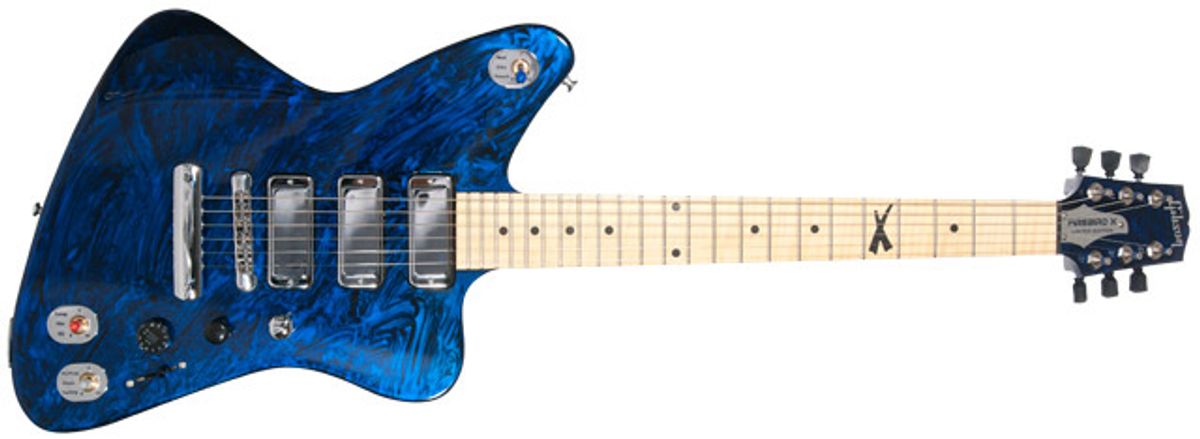
If you remove any preconceived notions or expectations, the Firebird X is a pretty cool guitar, both in sound and function.
Gibson’s electrics are icons and pillars of electric guitar history. So when a company with this much of a legacy comes out with anything that breaks the mold, you know there’s a chance of trouble. These days, it’s the forward-thinking Firebird X is the radical instrument that’s got the pot all stirred up. Even before its release, the Firebird X was the subject of major scrutiny online. Some purists considered it an affront to an icon. Premier Guitar’s own Facebook page posting for this guitar in the “Gear We Just Got For Review” album provoked a barrage of inflammatory comments so intense you’d think that Jackie O came back from the dead to star in Jersey Shore.
But if you remove any preconceived notions or expectations, the Firebird X is a pretty cool guitar, both in sound and function. Much negativity is based on the Firebird X’s look, which for many, tarnishes a traditional image of what they perceive Gibson—and the legendary Firebird design—to be all about. For my taste, it is a bit over the top, and I’d prefer a more conventional finish with a typical Firebird headstock. But as they say, you shouldn’t judge a book by its cover.
Unboxing the X
The guitar is nestled inside a hybrid gig bag/hardshell case called the ProX that can allegedly keep the guitar safe even from a six-story drop—I didn’t try. A well-stuffed briefcase-like accessory pack is also part of the package and contains a ton of essentials including two big pedals—the Blue Lightning Pedalboard and Switchboard, the G-Node 48k 24-bit audio interface and an accompanying stereo cable, eight rechargeable Lithium Ion batteries, and a ton of cables, chargers, and straps. You also get online access to the editor software as well as copies of Guitar Rig 4 and Ableton Live Lite 8 Gibson Studio Edition.
Because of the mind-boggling number of options and its steep learning curve, the Firebird X demands pretty serious dedication—especially if you’re going to make it your main gigging guitar.
Free-spirited Firebird
Although the Firebird X is inspired by the Firebird, it bears little resemblance to the classic ‘Birds associated with Johnny Winter and Brian Jones. The Firebird X has a chambered Swamp Ash body and come in a swirl finish (available in blue or red) that’s inspired by the way the floor of Gibson’s Nashville factory looked after the flooding in May 2010. Its 23-fret maple neck has a “C” shaped profile, 12” radius, and a curly maple fingerboard.
With three silver-covered mini humbuckers (Alnico V, Ceramic, and Anico II in the neck, middle, and bridge positions, respectively) and a piezo pickup, the Firebird X’s pickup configuration offers a whole lot of options—more than 2,000 according to Gibson. However, the control layout is bound to give you option anxiety. Sure it has knobs for volume and tone (here called the Digital Varitone), as well as a 5-way pickup selector switch (you don’t see that too often on a Gibson.) But there are also unexpected controls including an illuminated knob that Gibson calls the Gear Shift knob—which is sort of the heart of the unit, and three sets of tog-pots—which are equal parts toggle switch and rotating pot. The blue tog-pot chooses the time-based effects (modulation, echo, and reverb), the red tog-pot chooses the distortion effects (compression, distortion, and EQ), and the silver tog-pot chooses the pickup configuration or tuner. If that wasn’t enough, on the upper side of the guitar body are corresponding slider controls for the blue and red tog-pot effects.
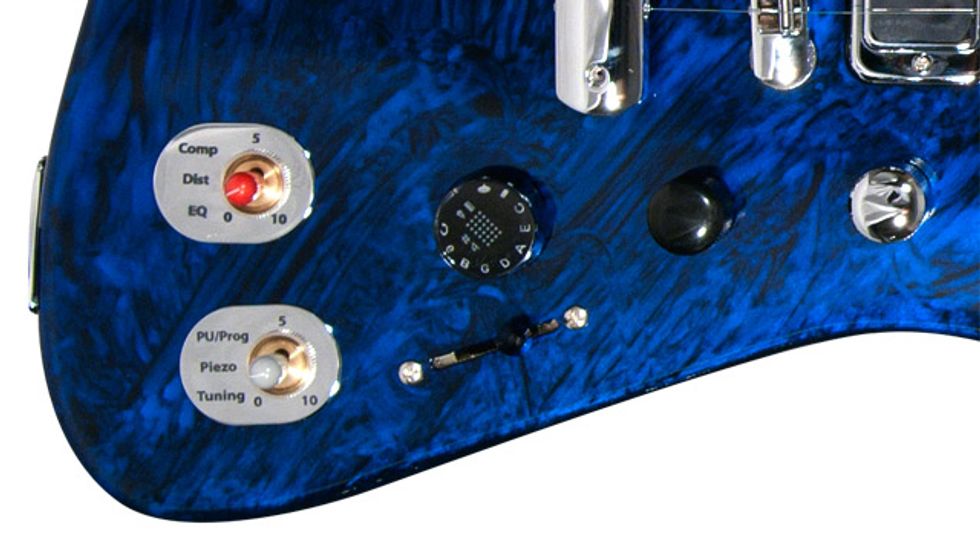
Robot Roadies
One of my favorite features of the Firebird X is the Robo-tuners, which made their debut several years earlier on the Gibson Robot Guitar. These computerized tuners look like traditional Tune-O-Matics, but have a small motor that automatically tunes your guitar in seconds to one of the many preset tunings offered. The tuning selections are Standard, Drop-D, Eb, DADGAD, Open G, Open E, Low D, Open A, Open Ab, Open G, Double Drop-D. You can also create and load up to 55 custom tunings into the editor and dump them into the guitar from your computer using the supplied stereo cable and G-node interface. While some view these tuners as a gimmick, personally, I think they’re awesome. I’m a sucker for convenience and to go from Standard to say Open Ab then Double Drop D with just a quick flick of the silver tog-pot and a twist of the Gear Shift knob and one strum is a big plus in my book. In general, on a gig I’d usually bring more than one guitar if the set had songs that changed between vastly different tunings. These polyphonic Robo-tuners take that whole problem out of the equation and open up a whole slew of possibilities.
The Robo-tuners work well in general although there were some instances in the beginning where some strings didn’t quite get there and I had to re-tune it. Gibson, though, says that the more you use the tuners the faster it will get it right. From the factory, the Firebird X comes setup with gauges .010–.046. It’s important, too, to note that the Robo-tuners will only work with a specific range of string gauges; the lightest being .009–.042 and the heaviest being .011–.052.
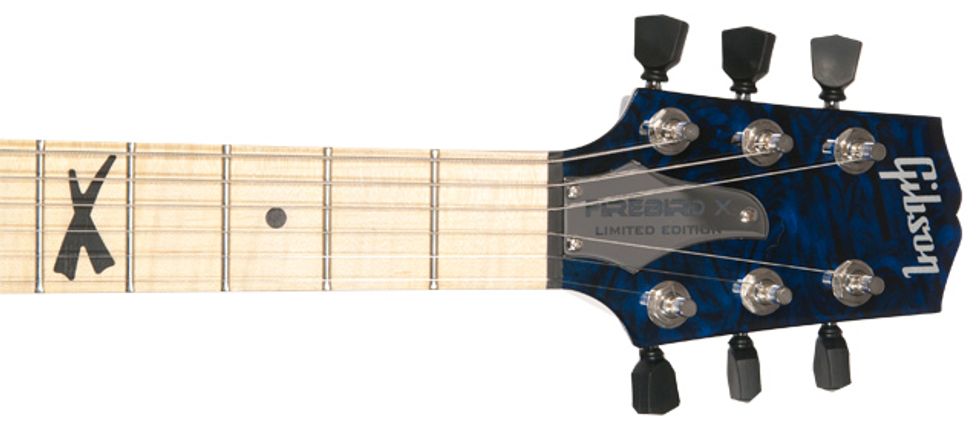
Learning Curve
One good thing about The Firebird X’s steep price tag is that if you spend that much on it you’d probably be more inclined to invest the time to really learn the ins and outs of the instrument. And to get the most out of the Firebird X, you’ll have to spend a lot of time with it as it has an insane amount of options. It’s definitely not a plug and play instrument, as I found out when, immediately after taking it out of the case, I plugged in and got—no sound. After consulting the manual for this most basic of tasks, I had my ‘Doh!’ moment when I learned that the Firebird X has to be turned on. This is accomplished by pulling up on the Gear Shift knob and it stays in this position until you turn the guitar off by pushing it back down. This was the first instance in what seemed like a seemingly endless series of manual consulting and I think most people would need to keep the manual handy until they really get up and running. The Firebird X definitely isn’t the kind of guitar you would bring to a gig just a couple of hours after getting acquainted with it.
My test unit’s battery was DOA so I put it in the charger and just popped in another of the replacement batteries that came with the package. Though Gibson says you can get at least two hours from each battery, I only got about 20 minutes straight out of this second battery, which was slightly worrisome—Gibson says they're aware of battery life concerns and are working on improvements. When I fully charged the first battery, I then got about an hour out of it although it seemed like the tuner wouldn’t come on when I hit the five minutes remaining mark. The Firebird X won’t work without a battery so battery life can be a serious concern if it’s is your only guitar on a gig or session. The lesson here is that if you’re taking this guitar out, you have to stay on top of the battery and charging situation and keep plenty of spares on hand.
Play Me
There are 55 factory patches, which are grouped as 11 banks (accessed by the Gear Shift knob) with five patches for each bank (accessed by the 5-way pickup selector switch) and can be accessed either from Patch Play mode or Edit mode. In Patch Play mode, you get the presets as programmed from the factory but you can’t tweak them. However, the red and blue tog-pots can be rotated to control the amount of distortion and reverb, respectively. Edit mode lets you manipulate the parameters of the effects so you can fine-tune them to your needs. To enter Edit mode, you quickly push down twice on the Digital Varitone knob and the Gear Shift knob will turn violet. Patch editing gets even deeper when interfaced with a computer, offering seemingly infinite options that can be created, shared, and saved to the 55 patches.
The Firebird X features a full compliment of effects that can be used simultaneously including distortion, reverb, delay, chorus, tremolo, octave, phaser, and flanger, to name just a few. There’s even a built-in three-track looper (remember Gibson also sold the TGE-05 Echoplex Digital Pro Plus rackmount looper, so this technology is not new to them). The included Blue Lightning Pedalboard and Switchboard is an essential part of the whole package and connects to the Firebird X via Bluetooth, so there’s no cabling between the guitar and the foot controls. They offer a visual display of parameters, settings, and battery life, among other bits of important information, and also enable foot control of the looper functions. Without the display, I would have been lost trying to guess my way around the numerous presets and settings.
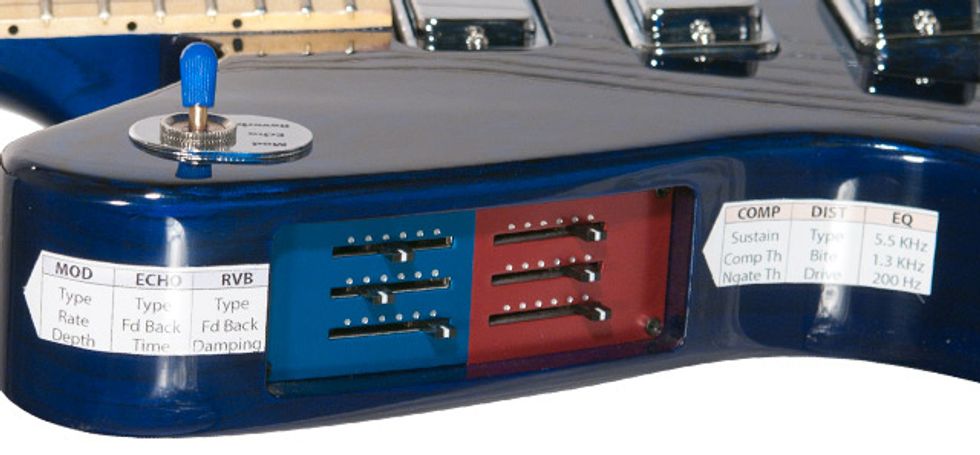
The Firebird Soars
As a straight-up guitar, the X sounds great. The first four banks contain Firebird, Single-coil, Humbucker, and acoustic pickup configurations and sounds. In other words, the X has the fundamentals covered and it wasn’t hard to dial up a variety of basic sounds from Paul Kossoff-inspired classic rock to Green Day power chords to hair metal shred with just the conventional pickup choices. You can also choose any of the above-mentioned configurations to use with the effects by moving the silver tog-pot to PU/Prog position.
I enjoyed some of the Piezo sounds like the J-200. It’s a credible emulation and would be fine on most gigs that require an occasional acoustic part. The Old Jazz patch also sounded pretty convincing. It was definitely strange to hear dark, hollow-body smokiness emanating from this flashy axe but I was still able to play some old-school jazz runs that sounded great. I also enjoyed many of the effects like the tremolo and phaser.
The neck on the Firebird X is easy to play, feels pretty fast and enables great upper fret access from the contoured neck joint. It isn’t quite as comfortable as the other Gibsons in my arsenal (a Les Paul Standard and ES-339), but it’s easy to imagine it becoming a familiar shape under the fingers.
Technophobe
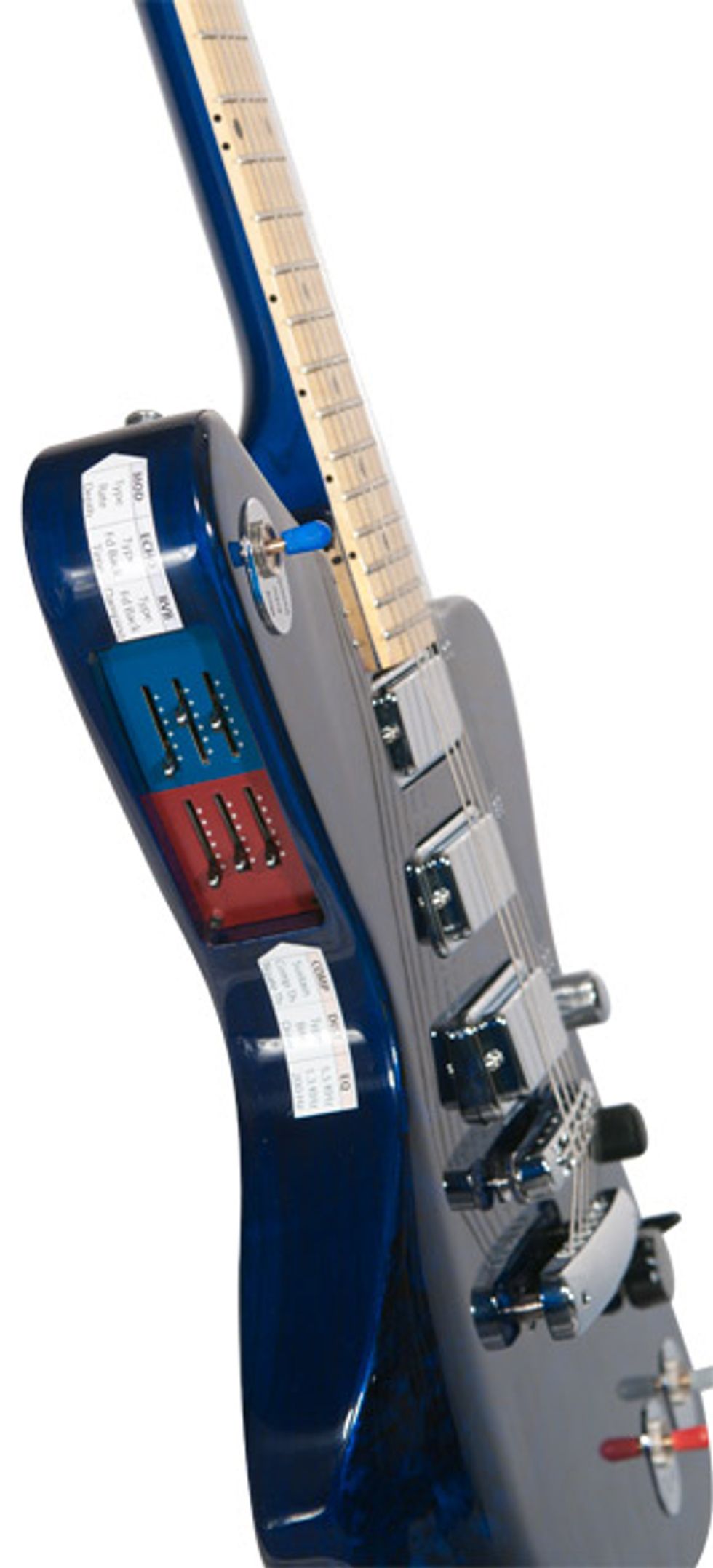 Because of the mind-boggling number of options and its steep learning curve, the Firebird X demands pretty serious dedication—especially if you’re going to ditch a standard guitar with pedalboard or multi-effects setup and make it your main gigging guitar. It’s like a more extreme version of going from PC to Mac, where you’ll have to re-think and re-configure familiar tasks.
Because of the mind-boggling number of options and its steep learning curve, the Firebird X demands pretty serious dedication—especially if you’re going to ditch a standard guitar with pedalboard or multi-effects setup and make it your main gigging guitar. It’s like a more extreme version of going from PC to Mac, where you’ll have to re-think and re-configure familiar tasks.
An obvious concern with any digital-based technology is its rapid obsolescence rate, and that’s been a hot topic with the Firebird X, just as it has on other techno-centric guitars guitars like the Fender VG Strat and the Line 6 JTV-6 Variax guitar. The most practical mindset to adopt when considering the Firebird X might be to consider the guitar within the context of your current needs rather than looking at it as a lifelong investment. Axe-Fxs and Macbook Pros are ultra popular these days but will they still be cutting edge in five years? Probably not, but in those five years, you might get a whole lot more done with them then you would resisting technology.
And from an optimistic angle, the Firebird X’s software is infinitely upgradeable with firmware updates, as is the internal DSP hardware, which is on a chip that’s user-replaceable, so it’s conceivable that this guitar would be viable for the foreseeable future (hey analog pedals are hotter than ever, right?). Whether Gibson will still support it or have parts in 10 years remains to be seen, but they have poured an enormous amount of money and time into R&D (several million dollars and 6 development teams around the world) so it’s very possible that they will. The company's plans to offer regular firmware updates and a coming app store open to third party apps seem to support that possibility.
The Verdict
If you’re one of those cynics that had an adverse reaction to the Firebird X when it was first announced, there’s probably little that will get you to change your mind. And if you’re perfectly happy with your guitar and effects setup and don’t mind lugging around multiple instruments to gigs and sessions, you might not have any use for it—in fact, if you’ve mastered your setup, you’d probably be better off sticking with it. However, if you actually tried the Firebird X out and really put in the time to get into its features and sounds (rather than reading about it on forums), you’d find that in addition to just offering great conventional guitar sounds, the guitar’s versatility can exponentially increase your sonic palette and inspire you to go to new places musically. It certainly did for me.
Buy if...
you want a fully integrated, feature-packed self-contained guitar and effects package that can thoroughly cover virtually any gigging or recording duties, and have the money and time to get the most out of it.
Skip if...
you can’t be swayed into thinking that Gibson should produce anything other than traditional instruments.
Rating...
|
MSRP $5570 - Gibson - gibson.com
|

